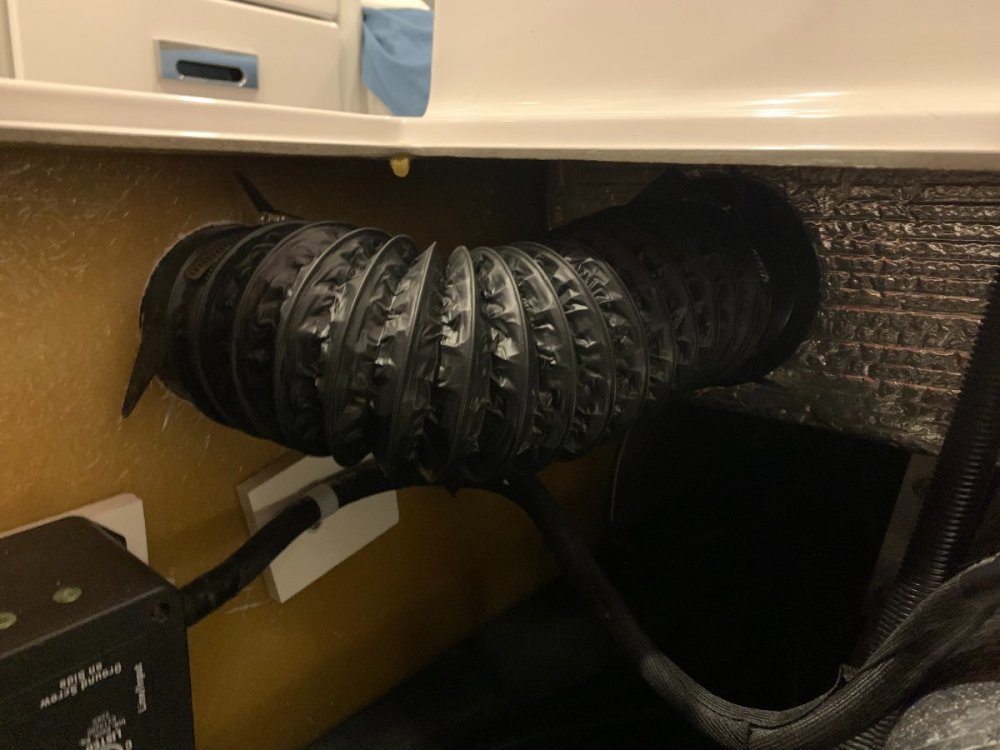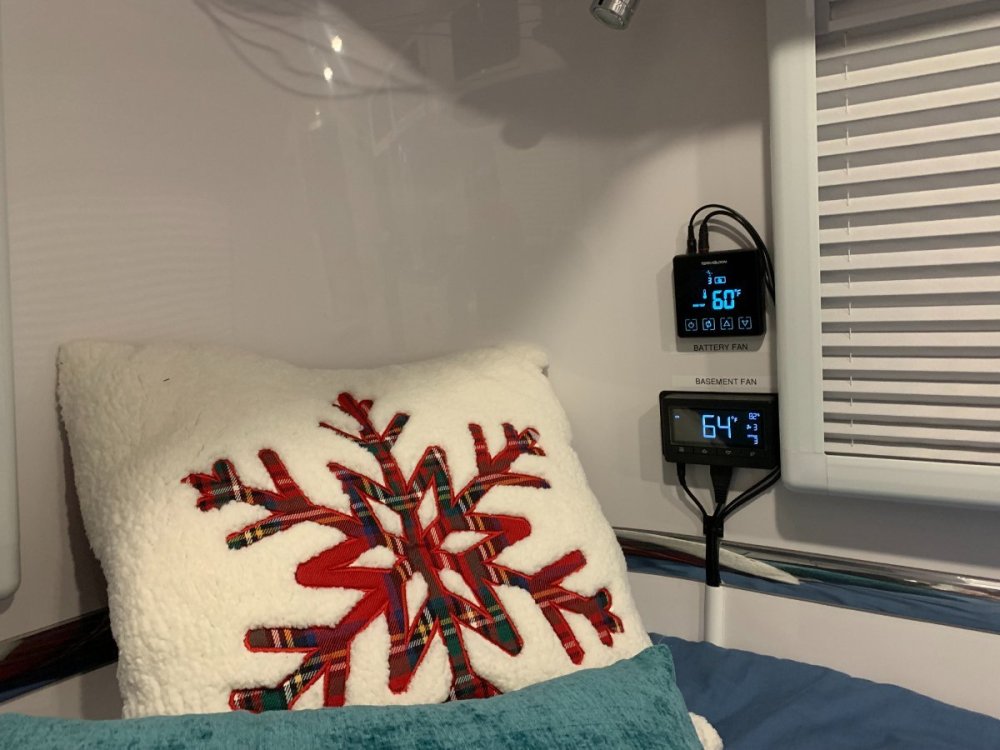-
Posts
383 -
Joined
-
Last visited
-
Days Won
10
Everything posted by NCeagle
-
2021 Elite II Dometic AC Model Number?
NCeagle replied to connor77's topic in Mechanical & Technical Tips
I'm on my second summer in NC with the Houghton and I've used it a LOT. I regularly use our Ollie as a quiet place to relax year round even when at "home". I do agree with all of @katanapilot's reasons, pretty much in that order too. My wife and I both agree that it's easily the best "luxury" modification we have made to our Ollie (second would be installing a dedicated shower mixer with the High Sierra head). @connor77, I tried to sell the lightly used Dometic on Craig's list for about half of what it's worth (as suggested by @Trainmanabove). I only tried Craig's list as I didn't want to deal with shipping. Never had any interest or offers so I gave up after about a month. Still sitting in my garage today. No chance I'll ever reinstall it, so I may end up giving it away - I'll wait until you have sold yours though. 😉 -
Great question! 🙂 These are sticky on both sides and I did take the backing off and stick them up there thinking no way they'd come down. However, they did start to come loose on the corners over time - nothing sticks great to the shiny waxed Ollie interior for long! That's why I use the white tape on the corners - to keep them from coming loose. So far so good.
-
I hate bugs and they love me. I have only met a few people in my life (my dad being one of them) where bugs will pick on them instead of me. One of the first things I did was replace all the screens with no see um screens, but inevitably bugs still get in through the open door, etc. I chased them around with a fly swatter, had zapper lights (that attract lots more bugs!) and various other methods all mentioned - as well as some that could probably have made America's Funniest Videos. One thing I noticed (after wiping up hundreds of splats) is that they tend to fly straight up to the bright white ceiling, so I put some sticky pads up on the ceiling and viola - I don't get attacked by bugs in the cabin anymore and I don't have to chase them around. I just replaced mine prior to our last trip, so these are still pretty "clean":
-
@John E Davies, I used plastic retainer clips for a while but the vhb tape on them didn't hold for very long on the shiny, waxed gelcoat. I've also been using a noodle for about a year now! I do want to put on some semi-permanent clips eventually - for looks, functionality and convenience. I have to find some decent stainless clips and I'll try 3M 4000 adhesive/sealant. Either way, "Secure the shower hose" has always been on our pre-departure checklist. 🙂
-
The hatch I used was 14" x 24" and fit perfectly width-wise as the inside cutout required was 13". I also had to enlarge the height of the opening and removed a few inches from the bottom (protected area I was cutting with masking tape) just as @mossemidid.
-
Stinky composting toilet 2 weeks into first trip
NCeagle replied to Donna and Jim Y.'s topic in General Discussion
We have found through experience that excess moisture can definitely be a problem with the NH - we've encountered the problem more than once camping in high humidity. What happens is when it's humid inside the trailer the medium in the NH absorbs the moisture from the air and becomes way too wet. The lack of "good" airflow and extra moisture in the bathroom from showers exacerbates the problem as does running the bathroom fan with the door closed - which effectively reverses the airflow over the NH medium and if the outside air is humid, the medium quickly becomes too wet. We've taken several steps to mitigate moisture problems and haven't had any in quite a while. Here's some ideas that have been mentioned by others... 1. Run a small dehumidifier inside whenever the humidity outside is above 50% (almost always here in the Southeast). 2. Start with as close to 100% dry medium in the NH as you can. We use a coco coir brick and I add water to break it up a week before we leave. I then keep the inside of our trailer at a lower humidity and let the medium dry out. A tiny bit of moisture is ok to keep dust down, but dealing with a little dust on the fan / filter is much better than trying to dry out a soupy mess in our opinion. 3. In general, think about airflow over the NH medium and take steps to mitigate excess moisture if necessary. This means thinking about the airflow and quality of the air going through the NH during different scenarios - bathroom fan on/off, bathroom door open/closed, outside air quality, etc. You can also tell with experience from turning the crank whether or not the medium in the NH is too wet (heavy) or getting too wet and in need of some dry air for a while. -
Hi Grip, there are tons of posts on the forum that cover various aspects of trailering and camping in cold temps with an Ollie. To sum it all up, if you haven't made some modifications to heat/protect some of the more vulnerable plumbing areas (outside shower, check valves on the exterior water inlets and from under the bathroom sink to the toilet) it's generally recommended to leave your plumbing winterized - especially while traveling in freezing temps. While camping, freezing temps won't be as dangerous to the plumbing, especially if you keep your propane heat on as that does help keep the basement warmer. Everything depends on the conditions of course (temperature, wind, duration...). Probably not the answer/advice you were hoping for, but I'd say better safe than sorry. 🙂
-
We may carry more than most camping, but it would be way too "borderline" for us with a payload capacity of 1395 / towing capacity of 6800 - well, maybe if I was alone I could squeeze it out. For example, here's our weight calculations for what we carry in our 3/4 ton pickup on a typical ~2 week camping trip: Essentials: Ollie tongue weight - fully stocked with food / clothing / full fresh water tank + other essentials (620 lbs), Passengers (300 lbs) + BIG doggy (100 lbs) = 1020 lbs. Various tools (58 lbs), Emergency gear (39 lbs), 20 gallons drinking water (166 lbs), Clam tent, stakes, hammer (49 lbs), Camping chairs & table (42 lbs), propane fire pit (24 lbs), outdoor rug (11 lbs), camp chef propane stove (8 lbs), hiking gear for two (23 lbs) = 420 lbs. Non-essentials (combination of following depending on type of trip): Generator + generator stuff (70 lbs), extra full 20 lb propane tank (36 lbs), spare solar panel (41 lbs), 2 e-bikes (100 lbs) = 247 lbs. Sure, we could jam more into the Ollie with heavy stuff near the rear to reduce tongue weight and payload, but it becomes even more dangerous and not fun (imo) when the overall trailer weight is approaching the tow vehicle weight / limits. John
-
HOW TO: Lithium Battery Powered Vent System
NCeagle replied to John E Davies's topic in Ollie Modifications
Hey Fritz, I used 2 different controllers because they are two different brands of fans. The brand that I had already installed for my basement bilge fan had a 4" diameter fan, but it wouldn't fit in the space under the bed (on top of the wheel well), so I ended up getting the other brand of smart fan that fit very snugly in that space. Had I started with the battery compartment first, I likely would have gotten the 6" diameter version of the one I ended up using under the bed. -
HOW TO: Lithium Battery Powered Vent System
NCeagle replied to John E Davies's topic in Ollie Modifications
@Fritz, yes they are separate installations and independent fans and controllers. I think the two solutions could be combined but may not be as efficient, especially for the battery compartment. Thanks! John -
Ok, I did post some photos of the battery box design I used in John Davie's original how to post: https://olivertraveltrailers.com/forums/topic/5301-how-to-lithium-battery-powered-vent-system/ I also noticed that I never posted pictures of my bilge / basement solution. It's pretty simple - bungee cord simple. 🙂 The fan only has a duct on the exhaust side so the fan pulls air from right under the seat and exhausts it into the cabin. When everything is closed up and the fan is running, the cabin air is pulled into the basement (primarily) through the existing heat return vent under the curb side bed, so cabin air is circulated throughout the basement pretty well when this fan is running (all the time in my case). Here's the 6" cabin vent under the dinette seat: And here's the smart fan and duct under the seat: I keep thinking I should make a more permanent mount for the fan, but it's held in there with bungees for over 5K miles without budging, so I've got that on the back burner. I also tapped into the back of the 120V receptacle under the seat right next to the fan for the power. I put the controller for this basement/bilge fan in the back of the cabin out of the way next to my battery compartment fan controller: Here's the smart fan and vent I used for this project: AC Infinity CLOUDLINE T6, Quiet 6" Inline Duct Fan with Temperature Humidity Controller - Ventilation Exhaust Fan for Heating Cooling Booster, Grow Te HG POWER 6 Inch Round Air Vent ABS Louver Grille Cover White Soffit Vent with Built-in Fly Screen Mesh for Bathroom Office Kitchen Ventilation
-
HOW TO: Lithium Battery Powered Vent System
NCeagle replied to John E Davies's topic in Ollie Modifications
Several folks expressed interest in seeing another design to keep the battery box temperatures moderated (for lithium batteries only!). This is an alternative option to John Davies' design. They are similar except that I chose to use a forced air closed system to moderate the battery compartment temperatures while John uses a combination of forced air and natural convection. This ended up being my final design and it has been working very well since last April (2021). My goal was to keep the sealed battery box as close to cabin temperature as possible (warmer in the winter and cooler in the summer - humidity controlled at all times, etc.). I stuck pretty close to my original design except that I did end up venting back into the cabin, so essentially I am just re-circulating cabin air through the battery box. It's a super-simple design and temperature and humidity sensors have proven this works as would be expected since this is a "closed" loop system. I do think this may be a bit difficult to follow unless you have had your head under the seats and beds, but here goes... Here's a picture from the cabin that shows the 2 (finished) 4" vents used for intake (under the street side bed) and exhaust (under the aft dinette seat): I'm going to start under the bed, which is the intake side in my design. This photo shows under the street-side bed where I cut the 4" hole into the aft side of the battery box: And this picture shows the installed ducting and smart fan under the street-side bed: Here's a view of the intake vent from inside the battery compartment (it's the partially obscured vent on the lower right front of the battery box): Working our way forward, here's a picture of the 4" exhaust hole in the battery box. It's partially obscured by the rail. It's located on the lower left back side of the battery box: Moving back inside, here's a look under the aft dinette seat at the 4" holes used for the exhaust back to the cabin: And here's what the exhaust looks like with the short piece of 4" duct in place under the dinette seat: That's pretty much it. I threaded the cables for the sensor and the fan control unit under the bed and put the controller for the battery compartment smart fan by my bilge (aka basement) smart fan controller. The controller lights can be turned off and these controllers are where my feet go on the bed, so they are not in the way and tucked out of sight behind the window shade for the most part: I know this doesn't include a lot of detail (i.e., I can't come close to the quality of John Davies' post!) about how I tapped into the 120V power (in the basement), the sealant I used with the vents, the hole saw I used, how I cut the holes, etc. , but here's a list of the parts and sealant used and I can try and help with any questions if anyone uses this design. TerraBloom ECMF-100, 4" Inline Duct Fan with 0-100% Speed Controlled EC Motor, Metal Case, Energy Saving. For Ventilation Boosting, Heating, Humidity AC Infinity Flexible 4-Inch Aluminum Ducting, Heavy-Duty Four-Layer Protection, 8-Feet Long for Heating Cooling Ventilation and Exhaust Soffit Vents 4 Inch Round Air Vents Louver with Screen ABS Grille Air Exhaust Vent for Ventilation System (100mm)... J-B Weld 31312 All-Purpose RTV Silicone Sealant and Adhesive - White - 3 oz. -
Hi Kirk, actually I cut 5 holes. Once you've gotten the nerve to do one, it becomes less painful! 🙂 One (6") hole was required for the bilge fan and it's under the front dinette (which is detailed by the post SeaDawg shared above). The battery compartment ventilation took four (4") holes. It's a different topic / problem altogether, but in a nutshell, my solution included a hole under the street side bed for intake and a hole under the dinette seat for exhaust in the cabin, and the battery compartment and smart fan are both "inline", so there is also a hole on each side of the battery compartment itself. I never posted pictures of my solution, but if there's interest let me know and I'll add some pictures and more detail in John's existing post as it's another approach to solving the same problem.
-
Another possible solution... A pair of 300 Watt heaters would draw about 50 amps when on (12V), so it's pretty easy to do the math and figure out how long they could run on batteries. I have 400 Amp hours, so I could theoretically run these bilge heaters for 8 hours with nothing else running. However, the cabin needs to be heated (if you use the furnace, that's taking more battery power to run the fan) and other small things need battery power as well. I came to the conclusion that heating the bilge electrically was not feasible with 400 Ah batteries, so I started looking for options to leverage the propane furnace. I chose a "smart" fan that I put under the front dinette seat with a vent (AC Infinity CLOUDLINE T6). I can run that at various speeds and it pulls cabin air through the heat vent in the back and pushes it back out the front. I've used temperature sensors to ensure cabin air is moving around the bilge. I have also found the bilge helps control the very high humidity in the bilge during summer months. In addition to this fan, I have run some extra heat ducts on the street side and pump a little furnace heat into the bilge as well as a few heat strips on the fresh and city water check valves (prone to freezing and cracking). I liked the bilge smart fan so much that I bought a smaller one (TerraBloom ECMF-100) and I use that to push cabin air through my sealed and insulated battery box to keep the battery temps moderated during both summer and winter.
-
NCeagle, 2020, Hull 688 Houghton 13.5K BTU I have run my unit in 90-100 degrees conditions under mostly direct sunlight as well at night in 70-80 degrees. It has cooled and controlled humidity very well. I think given the fact that we live in NC and camp year round (high heat / humidity in the summer) that a bigger 13.5K unit is going to be more efficient than a smaller 11K unit. Given my experience thus far, I really don't think 13.5K is overkill for an Elite II and I'd likely stick with the same size if I had to replace.
-
Lithium Battery Storage For Colder Climates
NCeagle replied to connor77's topic in Mechanical & Technical Tips
I don't have the experience and I don't live up North in a cold climate, but I thought about what I'd do given your circumstances... Without a doubt, I'd take them out and store them in the house / garage with a proper charge and reasonable temps. I think in Maine you might see some nights at or below 0F and I think they are pretty expensive to risk. That's my .02. 🙂 -
Compost Toilet V Traditional RV Toilet
NCeagle replied to Chris and Lisa's topic in General Discussion
I have to agree with @hobo. I also do the cleaning and my wife and I both seem to have no problem "aiming". The only learning curve is figuring out where to sit - and that's different for everyone. Once you figure that out it's easy peasy. 😁 -
Our Ollie is going to be bummed out this year considering the attention she got last year for her very first Christmas! This year she's getting a good bath, clay bar and two coats Meguiar's premium marine wax. Under the tree she'll find 3 cutoff valves (one for each of the lines leading to the outdoor shower and one for the fresh water intake line), some fuse labels as well as Timken bearing sets and seals. We're also going camping in December before Christmas, so she is getting a new red carpet runner and some Christmas pillows and lights to get us into the holiday spirit!
-
I don't think anything could "ruin" camping. Covid changed a lot of things, including camping. Smart phones changed a lot of things too that I didn't particularly care for, but I learned to live with them and even take advantage of them. I don't like all of the changes, but I'm sure not going to stop camping just because things are different. They will be different next year too. My wife and I have had a fantastic 2021 enjoying our new Oliver!! For the most part, we stuck to state parks and didn't see a lot of the problems others have reported. I can't wait to start our 2nd year of Oliver ownership - already have a trip planned in mid-December - yes, I did make reservations just in case. 🙂
-
I think it's a good idea to carry a spare pump as well. I found the exact match for the one installed in Hull #688 on Amazon: SHURflo 12v 3.0 GPM Revolution RV Water Pump # 4008-101-A65 In addition to checking the filter mentioned by @mossemi, I'd recommend treating your plumbing with a vinegar solution if you haven't already done so to see if that helps. We had some pressure issues shortly after taking ownership and it shocked me how much Ca/Mg can quickly build up and create pressure problems in the plumbing.
-
Wow, thanks for sharing @LCTraveler. I had never thought of that as a potential outcome of overfilling the black tank although I've been careful not to so far. As @SeaDawgsaid, it will help other owners (like me) that are also using the black tank this way. I definitely will add @John E Daviesstep to my "transfer process" - I think putting the NH vent hose in the shower basin prior to transfer (or flush) as a safety precaution is an awesome idea.
-
Here's my .02 on the subject... Our "giant" black lab (100+ lbs) camps with us quite a bit and he is fine sleeping on the floor in between the two twin beds. This is despite the fact that we set up the dinette bed just for him. 🙂 Once you have one giant dog, I really don't think two would be a huge difference since there's still plenty of room on the floor and dinette bed. Just adjustments as @SeaDawgmentions... for example, getting up to go to the bathroom at night with a giant dog laying in the hallway keeps everyone agile. Having two on the floor would just make the obstacle course to the bathroom longer. 😉 We also don't ever hang out inside during the day, even if it's raining - I think that would be challenging after a while with any animal (including humans).
-
Or, if you are like us, just do the research online, read multiple forums and just pull the trigger. 😁 We kept coming back to the Oliver Elite II over and over, so after about a month of research we ordered without even seeing an Elite II in person. The honesty of the owners on this site made it easier to do so. Happy to say we have ZERO regrets.
-
Charging Lithium Batteries
NCeagle replied to John C Marsh Jr's topic in Mechanical & Technical Tips
I suspect John has hit the nail on the head with the Charger current being set at 150 amps when the 1600 W the generator is running at is only able to support 133.33 amps (at 12V) theoretically. Given losses, I would predict that you can still use the 1600 Watts at 120V (13 amps) to charge your batteries at 100 amps (12V) without issue. I charge my pair of 200ah lithiums all the time at 40 amps (12V) because I have the time and I can - that fills my batteries at about 10% per hour. I'm not positive what John means by stating 13 amps (at 120 Volts) is marginal for lithium - I guess it's marginal if you only have a limited amount of time and 100 amps per hour is going to take too long - otherwise from my understanding you can charge lithium as slowly as you want - in fact, it's better for the ions / longevity if you charge at a lower amperage. -
Breaking Subzero | Oliver Furnace Mod
NCeagle replied to Minnesota Oli's topic in Ollie Modifications
@2008RN, the smart bilge fan I used is 120V. I just tapped into the 120V wire feeding the outlet under the forward dinette seat. I know the heating tape works very well while on the road although as I stated in another post recently, I don't consider myself an expert just yet as I still haven't towed in severe cold - only 25F for relatively short distances. I'm not sure about the truma as I have the standard water heater. I just make sure the water is hot before taking off on a cold drive. I also haven't had any problems driving with propane running the furnace, refrigerator and hot water heater.








.thumb.jpg.54bb6658a2a858286e7701f53a2adf61.jpg)
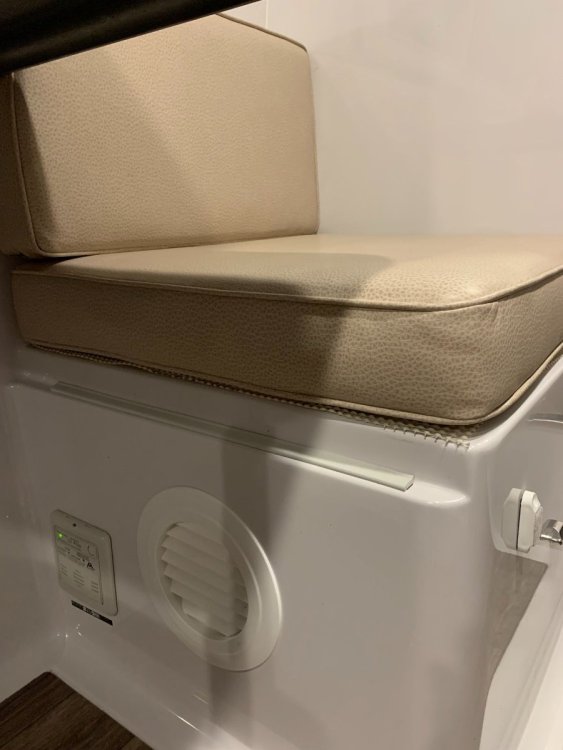
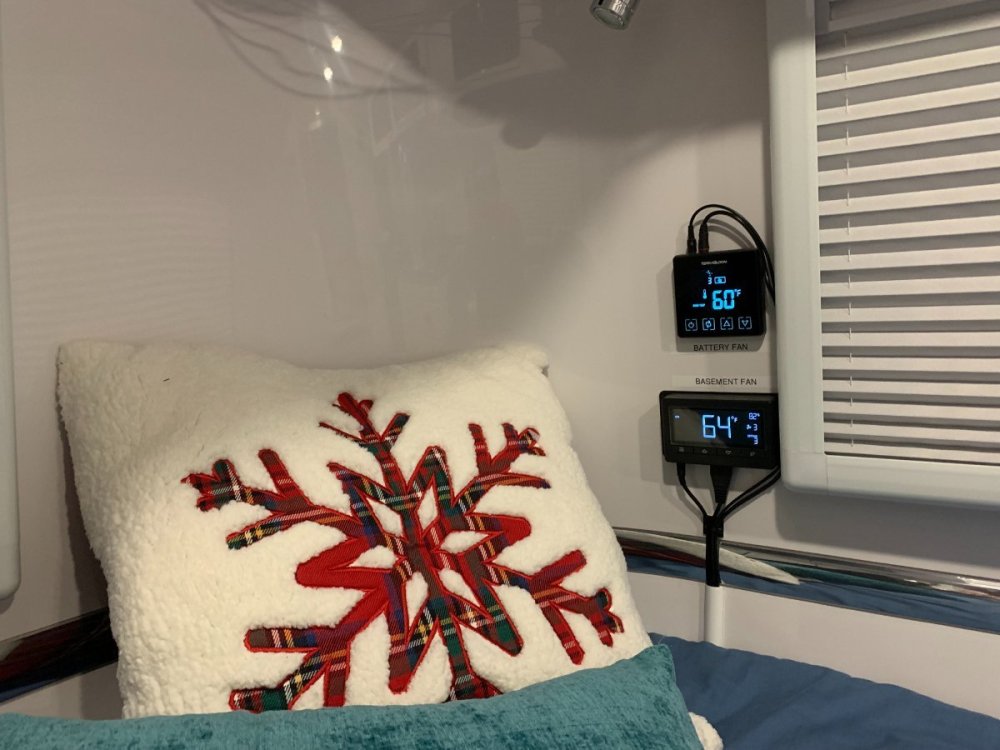
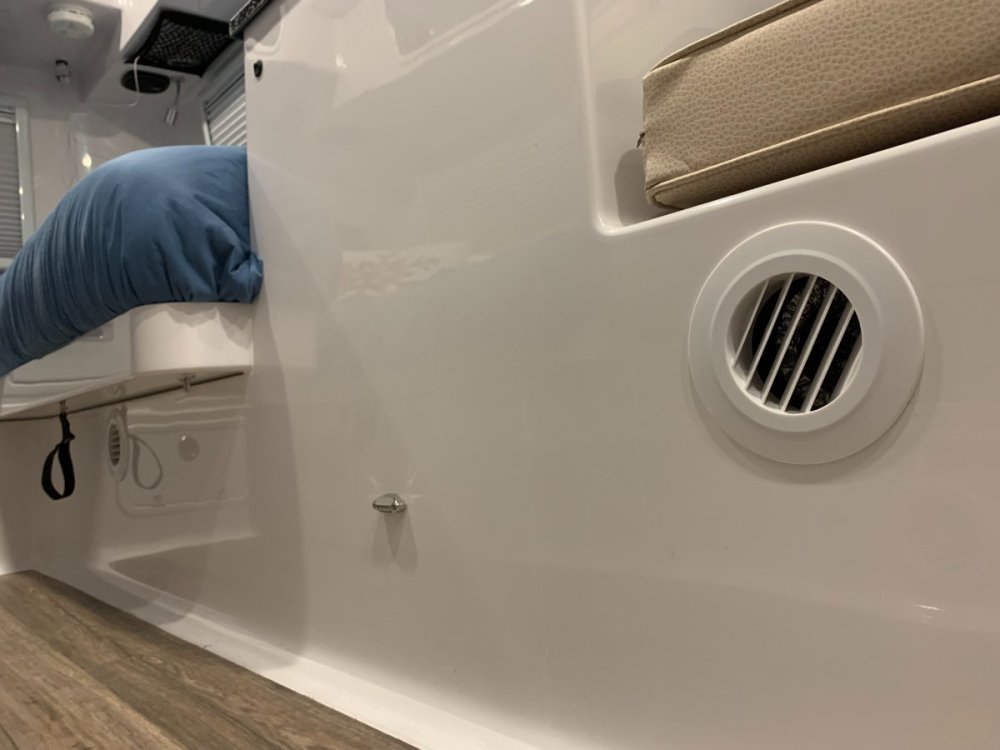

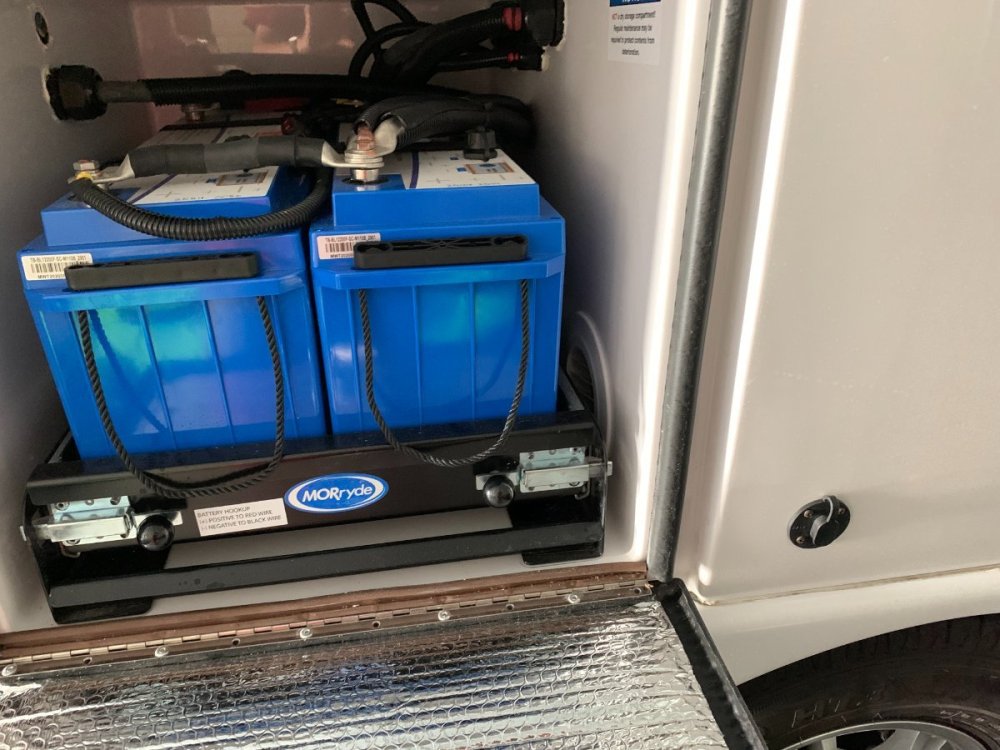
.thumb.jpg.005464071244b072df9d94370f5e7e21.jpg)
